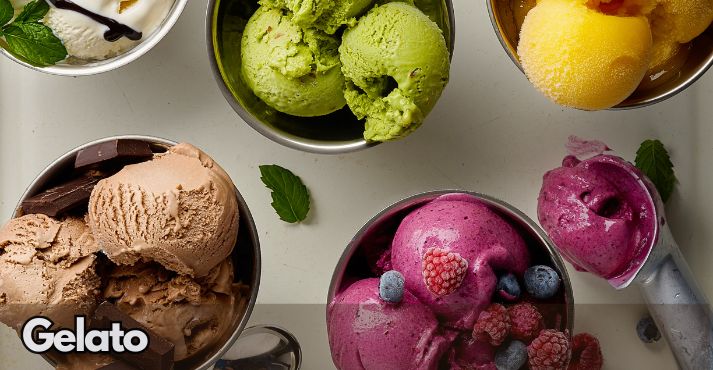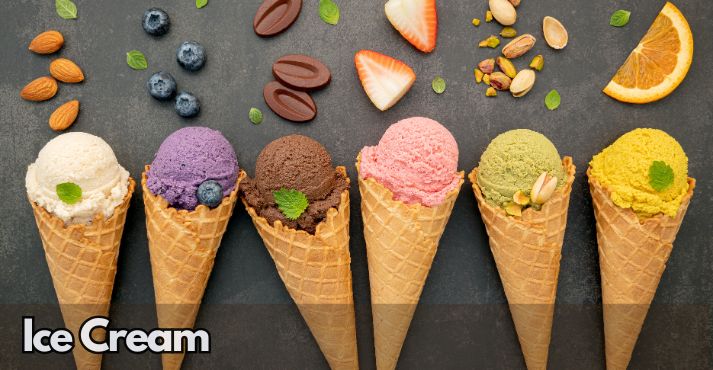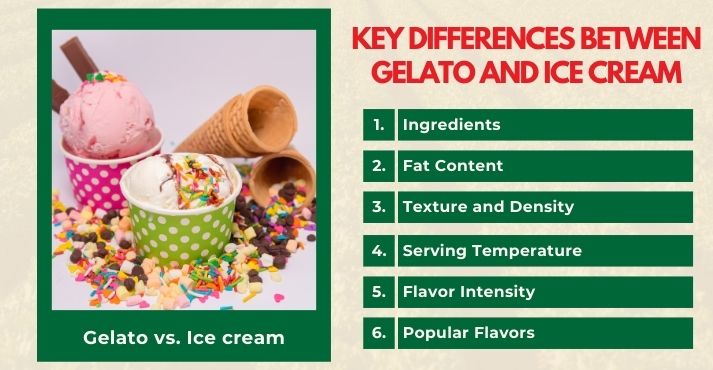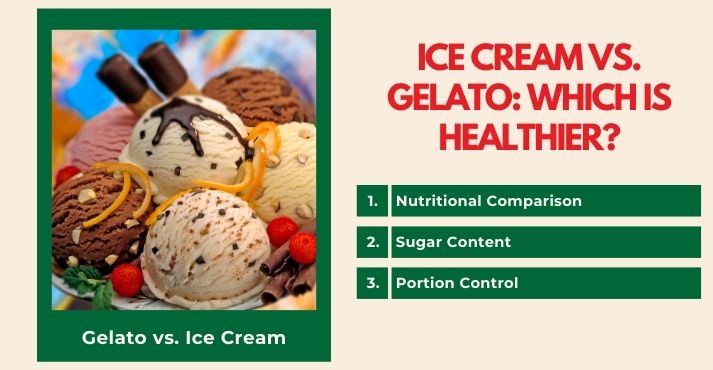Gelato and ice cream are two of the world’s most beloved frozen treats, but they have unique qualities that set them apart. While they may look similar at first glance, their ingredients and preparation methods make each different.
Whether enjoying them in Italy during a summer getaway or indulging at a local shop, these desserts offer a refreshing way to cool down. But, despite their shared popularity, many people are still curious about the difference between gelato vs. ice cream.
In this blog, we’ll explore the main differences between these frozen delights, from ingredients to textures and flavor profiles. Let’s check out what makes gelato and ice cream so special!
What is Gelato?

Gelato is a traditional Italian dessert known for its smooth, creamy texture. It differs from ice cream in both ingredients and preparation.
Gelato has a higher proportion of milk and less cream, resulting in a denser, more intense flavor. Its slower churning process incorporates less air, creating a luxurious, velvety texture.
Additionally, gelato is served slightly warmer than ice cream, enhancing its flavor and making it feel even creamier. Its lower fat content results in a light yet indulgent experience, with fruit or chocolate flavors that shine brightly in each bite.
How is Gelato Made?
Making gelato begins with combining milk, sugar, and flavoring ingredients like chocolate, nuts, or fruit purées. Unlike ice cream, which often includes egg yolks for added richness, gelato recipes usually omit eggs. Once the base mixture is prepared, it is pasteurized to remove bacteria, making it safe and smooth.
An important part of gelato production is the churning process. Gelato is churned using batch freezers, which operate at a slower speed than ice cream machines. This slow churning incorporates less air, resulting in the gelato’s signature dense texture.
One of the most well-known machines used in artisanal gelato production is the Carpigiani machine. This Italian-made freezer is designed to control the freezing process while maintaining the gelato’s smooth and creamy consistency.
After churning, gelato is stored in blast freezers, where the temperature is rapidly lowered to preserve its texture and freshness. This slightly warmer temperature prevents it from becoming too hard and enhances its rich flavors.
If you’re passionate about gelato, the Gelato Trade Show is a great place to explore new trends in the industry.
What is Ice Cream?

Ice cream is a beloved frozen dessert enjoyed worldwide for its light and creamy texture. Unlike gelato, ice cream is made with a higher cream-to-milk ratio. It’s also churned faster to incorporate more air, a process called “overrun.” This results in a light and fluffy consistency.
Ice cream is typically served colder than gelato. It has a firmer texture and diverse flavors, from fruity sorbets to indulgent chocolate or vanilla. Its creamy base offers endless flavor combinations and creative twists.
How is Ice Cream Made?
Ice cream begins with a custard base made of cream, milk, sugar, and egg yolks, which gives it a rich and smooth consistency. The mixture is then pasteurized to kill bacteria and homogenized to break down fat molecules, ensuring a creamy texture.
Once the base is prepared, it is churned in industrial ice cream makers or batch freezers, which operate faster than gelato machines. This rapid churning introduces more air into the mixture, increasing its volume and giving ice cream its lightness.
The degree of overrun, or air incorporation, can range from 30% to 100%, depending on the desired texture and quality of the ice cream.
After churning, ice cream is transferred to blast freezers or hardening cabinets for freezing. This step stabilizes its texture and prevents the formation of large ice crystals.
Many large-scale ice cream manufacturers use continuous freezers, allowing consistent, high-volume production while maintaining an ultra-smooth texture. The colder storage temperature ensures that ice cream remains firm and scoopable, making it easier to serve in various forms, from cones to sundaes.
Key Differences Between Gelato and Ice Cream

[fusion_table fusion_table_type=”1″ fusion_table_rows=”” fusion_table_columns=”” margin_top=”” margin_right=”” margin_bottom=”” margin_left=”” hide_on_mobile=”small-visibility,medium-visibility,large-visibility” class=”” id=”” animation_type=”” animation_direction=”left” animation_speed=”0.3″ animation_offset=””]
| Features | Gelato | Ice Cream |
|---|---|---|
| Ingredients | More milk, less cream, minimal or no egg yolks | Higher cream content, often includes eggs |
| Fat Content | Lower fat (4-8%) | Higher fat (10-20%) |
| Texture | Denser, smoother, less air incorporation | Fluffier, airier due to more overrun |
| Serving Temperature | Served warmer (10-20°F colder than ice cream) | Served colder (0-10°F) |
| Flavor Intensity | More intense, bold flavors | Creamier, softer flavors |
| Popular Flavors | Pistachio, hazelnut, stracciatella, tiramisu | Vanilla, chocolate, cookies and cream, mint chocolate chip |
[/fusion_table]
Gelato and ice cream are two of the most popular frozen desserts worldwide. However, they differ in several areas, from ingredients to texture and flavor intensity.
A comparison of ice cream and gelato can help clarify these differences, making it easier to choose based on your preferences. Whether you enjoy the creamy richness of ice cream or the smooth, intense flavors of gelato, knowing the differences helps you choose the right dessert.
Below, we’ll explore the main differences and provide a comparison table to clarify them:
1. Ingredients
Gelato: The texture of gelato comes from its simple yet carefully balanced ingredients. It’s made with more milk and less cream than ice cream and typically contains minimal or no egg yolks. This brings out the natural flavors of ingredients like fruits and nuts, and the absence of egg yolks also makes gelato a bit lighter in texture than ice cream.
Ice Cream: Ice cream uses a higher cream content, which makes it richer and creamier. Many ice cream recipes also include egg yolks, which help create a custard base that adds to its smoothness. The extra cream and eggs create a heavier texture, giving ice cream its indulgent, creamy taste.
2. Fat Content
Gelato: Gelato has a lower fat content than ice cream, around 4-8%, so it feels lighter on the palate. Since fat coats the tongue and can slightly dull flavors, gelato’s lower fat content allows its ingredients, whether fruit, chocolate, or nuts, to shine more intensely.
Ice Cream: Ice cream typically contains 10-20% fat. This extra fat gives ice cream its rich, creamy texture and makes it feel more indulgent. The higher cream content also gives ice cream a smoother consistency and helps it maintain its structure when frozen.
3. Texture and Density
Gelato: A significant difference between gelato and ice cream is their texture. Gelato is denser and silkier because it’s churned at a slower speed, incorporating less air. This results in a smooth, velvety texture that sticks to the spoon and delivers a more intense flavor.
Ice Cream: Ice cream is lighter and fluffier due to more air introduced during churning. This process, known as “overrun,” gives ice cream its soft, airy consistency. While this makes ice cream feel light and creamy, it also slightly mutes the intensity of its flavors compared to gelato.
4. Serving Temperature
Gelato: Gelato is typically stored and served at a warmer temperature, around 10-20°F higher than ice cream. This allows it to maintain its soft, creamy consistency and enhances the intensity of its flavors.
Ice Cream: Ice cream is served at a colder temperature, usually between 0-10°F. This helps it hold its shape longer and gives it a firmer texture. However, the colder serving temperature can also slightly numb the taste buds, so ice cream flavors may not come through as strongly as they do in gelato.
5. Flavor Intensity
Gelato: Due to its lower fat content and denser texture, gelato has more intense, vibrant flavors. The absence of extra cream makes the ingredients’ natural taste stand out, making each bite more flavorful. Gelato is often made with simpler ingredients, letting its flavors shine without being overwhelmed by the cream’s richness.
Ice Cream: Due to its higher fat content, ice cream tends to have a creamier, softer flavor. This can slightly mute the intensity of the flavors. The creaminess of ice cream enhances the experience but can prevent the individual flavors from being as noticeable as they are in gelato.
6. Popular Flavors
Gelato: Gelato is known for its classic Italian flavors, which often highlight fresh, high-quality ingredients. Popular flavors include pistachio, hazelnut, stracciatella (chocolate chip), tiramisu, and fruit-based options like lemon or raspberry. The focus is on using high-quality, simple, and naturally flavorful ingredients.
Ice Cream: Ice cream offers a wider range of flavors, from traditional choices like vanilla and chocolate to more indulgent varieties such as cookies and cream, mint chocolate chip, or caramel swirl. While ice cream can have unique and creative flavor combinations, its creamy base pairs well with indulgent ingredients like cookie chunks or candy pieces.
Ice Cream vs. Gelato: Which is Healthier?

Many people consider the health implications of gelato and ice cream when choosing between them, especially regarding calories, fat content, and sugar.
While both treats can be enjoyed in moderation, there are differences to be aware of, especially if you’re making a health-conscious decision.
Let’s explore how these two frozen desserts compare nutritionally:
Nutritional Comparison
- Calorie Differences: Gelato typically has fewer calories than ice cream. This is primarily due to its lower fat content and less air, making it denser and often served in smaller portions.
- Fat Content: Gelato has less fat than ice cream. With around 4-8% fat compared to 10-20% for ice cream, gelato provides a lighter option in terms of fat intake, making it a preferable choice for those watching their fat consumption.
Sugar Content
Both gelato and ice cream contain sugar, though the levels may vary slightly depending on the recipe and flavor. Due to their sugar content, both should be consumed in moderation. Sugar can lead to excess calorie intake if not balanced with other nutrients.
Portion Control
Portion size significantly impacts overall calorie and sugar intake. Gelato, being denser, is often served in smaller portions, which can help with portion control. On the other hand, ice cream is lighter and may be served in larger quantities, leading to higher calorie consumption per serving.
Conclusion
Choosing between gelato and ice cream depends on your texture, flavor, and dietary preferences.
Gelato offers a denser, more flavorful experience with fewer calories and lower fat content, making it a lighter option. With its rich, creamy base, ice cream offers a wider variety of flavors and a more indulgent experience.
Whether you opt for ice cream or gelato, pairing them with the world’s favorite pastries elevates the experience, making it a treat for any occasion.













